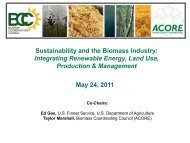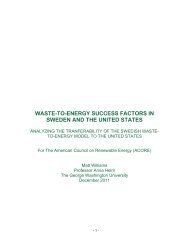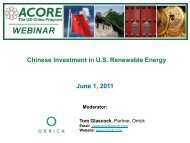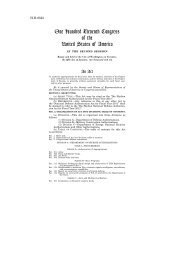Independent third-parties should alsoundertake in periodic verifications ofemission reductions realized.• Measurable – The reduction should bemeasured using accepted methodologies.After measurement, the offset credit mustonly be counted once and then retiredthrough a credible registry system.Carbon projects developed today in a mannerconsistent with expected federal US standardswill have the best chance of future recognitionand value.Josh Green, CEO of the Verdeo Group, predicts that nocompliance for carbon projects will be required in the USuntil 2013. The Clean Air Act is unlikely to be used toregulate greenhouse gas emissions. However, new carbonprojects must be “over and above” existing regulations tobe eligible for credit. It appears that a significant percentageof allowances for these particular carbon projects willbe auctioned initially, and will continue to increase overtime. There will be set-asides for early action granted toprojects certified and registered using “best practice”standards. Finally, offset credits from a variety of sectorswill be allowed to lower the cost of compliance.There is a forecast of growth in carbon markettrading.Zimmer described that most of current global carbonmarket has come from nitrous oxides, HFC-23 refrigerants,captured in industry. They have higher value andlower costs of recovery. These waste gas recovery projects(75% of total credits traded) will decline to 25% of totaltrading value by 2012, according to New <strong>Energy</strong> Finance.Their costs of recovery are at $1.30, while renewableenergy and efficiency costs range from $6.50 to $20 forcomparable reductions. There has been an increasedpatent activity for clean technology and carbon tradingtools and administration. The US leads with largestnumber of renewable energy patents followed by Japanand Australia. Financial sector difficulties will meantightening credit markets. With growing environmentalconcern, it is likely that a shift will occur from waste gasrecovery and this movement to a clean technology basewill favor renewables.The transition to a low-carbon economy is astrategic process.An emissions trading system is an essential, yet insufficient,policy tool on its own in accelerating the transitiontowards a low-carbon economy. This is true for three mainreasons. First, given the urgency of climate change andthe combination of policy objectives governments aretrying to achieve (i.e. technology leadership, energysecurity, local air quality); a spectrum of measures will berequired. Second, not all sectors respond well to carbonpricing. Third, still in early days, it remains to be seen ifcarbon trading strategies will be fully successful inencouraging new investment. The precise program detailscan significantly influence the results, in terms of pricesthat customers have to pay, investment decisions andactual abatement achieved (lessons from Europe).Carbonprices are determined, influenced and formed by the threekey factors of fundamentals, design and behavior.Certain risks become apparent with an<strong>American</strong> cap and trade system.The following risks make implementing cap andtrade legislation in the United States difficult:• Regulatory risks, such as project approval,validation, and verification of emissionsreductionprojects.• Political risks, that could alter climate changepolicies and obligations, such as host-countryinstability, expropriation of credits, contractfrustration, credit confiscation, failedvalidation, and more.• Technology-performance risks, timing of capgoals with technology availability.• Carbon-financing risks, including an inabilityto secure or maintain financing based onprojected or volatile carbon-revenue streams.Credit value once received for carbon is atrisk of market flux.• Carbon-performance risks, associated withvariability in the generation, permanence, andownership of emissions reductions.• Counterparty credit risks, including the failureto deliver credits as contracted; and creditsupport for risk transfers.<strong>American</strong> <strong>Council</strong> <strong>On</strong> <strong>Renewable</strong> <strong>Energy</strong>Executive Summary Report 48
• Complexity and operating costs of newenvironmental derivatives after prior WallStreet experiences with various riskmanagement products, and linkages ofinternational carbon markets.• Clean Development Mechanism (CDM) creditsfrom projects in renewables, methane gasreductions, cement and coal bed methanereductions, supply energy efficiency, demandside energy efficiency, fuel switching,forestation projects, and other reductions.• Supply constraints, because Kyoto signatoriesare behind in their greenhouse gas reductioncommitments, and there is a shortage ofgood projects with carbon credits content.• Project financing gap growing, with up frontfinance required, only “pay on deliverycontracts,” project risks not shared butallocated to developer and not truly globalproject markets yet.Capital AccessThere are some real benefits for a private cleantechnology company to go public at an early stage.According to Robert Peterman of the TorontoStock Exchange, these benefits include thefollowing advantages: use share capital toacquire other companies and augment organicbusiness growth with strategic M&A activities,utilization of option plan to retain key employeesand conserve cash for growth, on-going ability tofinance growth by accessing capital markets asbusiness objectives are achieved, and liquiditypremium from investors, particularly givencurrent market conditions.By watching some strategic investors, a trendtowards renewable energy and energy efficiencyemerges.In the utility and oil industries, Duke <strong>Energy</strong> acquiredCatamount <strong>Energy</strong>, a wind power company, for $240million. Shell has invested $1 billion over the past fiveyears in renewable energy technologies. Chevron hascommitted to invest $100 million per year in renewableenergy. PG&E will invest $1.4 billion in developing solarpower facilities.In the industrial sector, General Electric <strong>Energy</strong> FinancialServices has a $4 billion portfolio of renewable energyassets, including Ionics, Comverge, SunPower, A123Systems, and number of Wind projects. GE will also invest$6 billion in renewables by 2010. There is a joint venturebetween DuPont and Genencor, where they have committedto $140 million over 3 years to develop cellulosicethanol solutions.The automotive industry has seen General Motors investin a biofuels start-up, Coskata, to speed the flow ofethanol for GM’s flex-fuel vehicles. In addition, all majorcar manufacturers in the US and abroad have invested indeveloping electric cars and related battery technologies.Finally, Google is planning to invest in solutions to generate1 GW of renewable energy from a coal-fired plant. Theyhave also committed up to “hundreds of millions” ofdollars to bring new technologies to market. Currently,Google is working with eSolar on its solar thermal powerinitiative as well as advancing geothermal power technologyand systems. They too have invested in a wind powercompany, Makini Power.ConclusionsThe state of renewable energy economicsevoked feelings of optimism and promise amidstthe uncertainty of a national and globaleconomic crisis. The <strong>American</strong> Reinvestmentand Recovery Act extended existing renewableenergy tax incentives, and created new ones tocatalyze the market in a time of credit shortage.Attendees’ confidence was also bolstered by themany state-level success stories shared, each,microcosms of the economic growth a nationalrenewable energy standard would created.Infrastructure barriers still inhibit renewableenergy scale-up, and economic uncertaintieslinger on in the volatile market. But all inattendance were inspired by the expandednational commitment to renewable energydiscussed at RETECH 2009.<strong>American</strong> <strong>Council</strong> <strong>On</strong> <strong>Renewable</strong> <strong>Energy</strong>Executive Summary Report 49
- Page 6:
The highlights of WIREC 2008 includ
- Page 9 and 10: EVENT SPONSORSHosted byBadge Sponso
- Page 11 and 12: EXHIBITORS ContinuedKamatics Corp.K
- Page 13 and 14: The ARRA contains the following ite
- Page 15 and 16: “How do we organize ourselves to
- Page 17 and 18: John GeesmanFormer Commissioner, Ca
- Page 19 and 20: Cathy ZoiCEO, Alliance for Climate
- Page 21 and 22: John CavalierManaging Partner, Huds
- Page 23 and 24: BiofuelsChristopher Groobey, Partne
- Page 25 and 26: Patrick Cloney, Executive Director,
- Page 27 and 28: Gal Luft, Executive Director, Insti
- Page 29 and 30: Daniel Kammen, Class of 1935 Distin
- Page 31 and 32: Biomass, Biofuels, and Advanced Veh
- Page 33 and 34: Critical development opportunities
- Page 35 and 36: ConclusionsSpeakers at RETECH 2009
- Page 37 and 38: Geothermal PowerOverviewThe United
- Page 39 and 40: Green Buildings and CommunitiesOver
- Page 41 and 42: Green construction and renovation s
- Page 43 and 44: Session ReferencesGreen Schools Bre
- Page 45 and 46: 1. The local electric power market
- Page 47 and 48: International Renewable Energy Indu
- Page 49 and 50: production was 37%; the domestic tu
- Page 51 and 52: There have been a number of incenti
- Page 53 and 54: educes mortality and improves gende
- Page 55 and 56: D7 - ChinaJing Su, Director of US-C
- Page 57 and 58: past, uncertain legislative environ
- Page 59: marketplace, accelerating and deepe
- Page 63 and 64: C6 - Environmental and Carbon Finan
- Page 65 and 66: The technology debate: thin film ve
- Page 67 and 68: FITs have grown in popularity over
- Page 69 and 70: Haroula Reitz, Global Manager of Sc
- Page 71 and 72: Currently, planning is geographical
- Page 73 and 74: Federal policy should allow for a c
- Page 75 and 76: Wind: Markets, Technologies, and Po
- Page 77 and 78: Regional FactorsBesides federal pol













